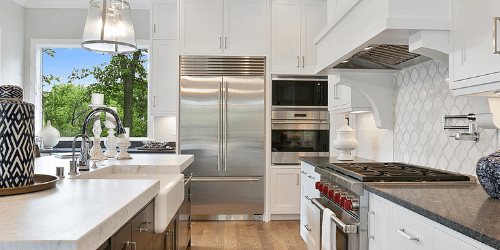Ensuring the proper installation of kitchen fixtures and appliances is crucial for both functionality and aesthetics. A well-installed kitchen not only enhances the cooking experience but also adds value to your home. In this blog post, we will explore the steps and considerations necessary to achieve a flawless kitchen installation.
Proper installation of kitchen fixtures and appliances involves careful planning, adherence to manufacturer guidelines, and attention to detail to ensure safety, functionality, and longevity.
Planning and Preparation
Assessing the Kitchen Layout
When designing your kitchen, begin by evaluating the available space to determine the most effective layout for fixtures and appliances. Consider the workflow efficiency by strategically placing appliances to create a smooth and functional workspace that minimizes unnecessary movement. Additionally, ensure that the layout is visually appealing and complements the overall design of your home, enhancing both the practicality and aesthetic appeal of your kitchen. This approach helps in maximizing space utilization, improving workflow, and achieving a cohesive look.
Gathering Necessary Tools and Materials
Before starting your installation, make a comprehensive list of essential tools, including screwdrivers, wrenches, and measuring tape, to ensure you have everything needed for a smooth and efficient process. Choose high-quality materials and fixtures, as investing in durable products will ensure long-lasting results and reduce the need for future repairs. Additionally, prioritize safety by equipping yourself with appropriate safety gear, such as gloves, safety glasses, and a dust mask if necessary, to prevent accidents and injuries during the installation. Proper preparation with the right tools, materials, and safety precautions will help you achieve a successful and safe installation.
Creating a Detailed Plan
Develop detailed blueprints and diagrams to guide the installation process, ensuring that each step is well-planned and coordinated. Establish a clear timeline and budget to keep the project on track and avoid unexpected delays or costs. Additionally, check local building codes and obtain any necessary permits to ensure your installation complies with all regulations and standards. Proper planning, budgeting, and regulatory compliance are crucial for a successful and hassle-free installation.
Installing Kitchen Cabinets
Measuring and Marking
Accurate measurements of the kitchen space are crucial for a seamless cabinet installation. Start by carefully measuring the dimensions of the area where the cabinets will be placed, including height, width, and depth, to ensure a perfect fit. Use a level and a pencil to draw precise guidelines on the walls, which will serve as a reference for cabinet placement and alignment. Before beginning the installation, conduct thorough pre-installation checks: verify that the walls are plumb by using a level to detect any deviations and ensure the floor is level to avoid complications with cabinet alignment and stability. These steps will help prevent common installation issues, leading to a professional and polished final result.
Securing Wall Cabinets
Mounting brackets play a critical role in ensuring the stability of wall cabinets. Begin by installing sturdy mounting brackets, making sure they are securely fastened to the wall studs to support the weight of the cabinets. Carefully align the cabinets with the marked guidelines on the wall, ensuring they are positioned correctly before securing them to the brackets. After mounting, use shims to make precise adjustments, ensuring the cabinets are level and aligned with the rest of the kitchen design. This meticulous approach ensures that the cabinets are not only functional but also visually appealing, providing a solid foundation for the rest of your kitchen installation.
Installing Base Cabinets
Position the base cabinets according to the layout plan, ensuring they are aligned with the designated areas and securely attached to the wall. Once positioned, connect adjacent cabinets using screws to create a seamless and cohesive look. Next, carefully install the countertops on top of the base cabinets, ensuring they are level and securely attached. This step is crucial for achieving a stable and aesthetically pleasing finish, as well as providing a functional surface for kitchen activities. Double-check all alignments and secure connections to ensure that everything is properly installed and ready for use.
Installing Kitchen Appliances
Preparing Electrical and Plumbing Connections
Ensure there are adequate electrical outlets strategically placed to accommodate all kitchen appliances, following relevant safety codes and standards. Verify that plumbing connections are correctly installed for essential appliances such as dishwashers and refrigerators, ensuring a secure and functional setup. If you are installing gas appliances, make sure that the gas lines are properly installed and thoroughly tested for any potential leaks. This step is crucial for ensuring safety and functionality in your kitchen, as well as preventing any future issues with electrical, plumbing, or gas systems.
Installing Major Appliances
Position the refrigerator in its designated space, ensuring it is level and has adequate ventilation for efficient operation. Install the oven and stove, making the necessary connections to the electrical or gas supply, and ensure they are properly aligned and secured. For the dishwasher, secure it in its designated spot, ensuring it is properly connected to both the water supply and the drainage system. This careful placement and connection of appliances is essential for optimal performance and functionality in your kitchen.
Testing and Adjusting
Test all appliances, including the refrigerator, oven, stove, and dishwasher, to ensure they are operating correctly and efficiently. Verify that each appliance is performing its intended function without any issues. Make any necessary adjustments to align doors, drawers, and other movable parts to ensure they operate smoothly and without obstruction. Conduct thorough safety inspections to check that all electrical, plumbing, and gas connections are secure and free from leaks. Ensure that all components meet safety standards and that there are no potential hazards present.
Installing Kitchen Fixtures
Installing Sinks and Faucets
To install a sink, first position it in the designated area, ensuring it is level and securely aligned with the countertop or cabinetry. Install the faucet by connecting it to the water supply lines, making sure all connections are tight and secure to prevent leaks. Once the faucet is installed, apply a high-quality sealant around the edges of the sink to create a watertight seal. Finally, test the sink by turning on the faucet and checking for any leaks around the connections and sink perimeter, addressing any issues promptly to ensure a proper installation.
Installing Lighting Fixtures
When choosing kitchen lighting fixtures, select options that provide sufficient illumination and enhance the overall design of the space. Ensure they are compatible with your kitchen’s layout and aesthetic. Follow all electrical codes for wiring and securely mount the fixtures to avoid any hazards. Once installed, test the fixtures to confirm they are functioning properly and make any necessary adjustments to achieve optimal lighting levels and ambiance.
Installing Ventilation Systems
To ensure effective kitchen ventilation, start by installing range hoods above the stove. These hoods are essential for removing cooking fumes, smoke, and odors from the kitchen. Connect the range hood to the ductwork, ensuring that all connections are secure and airtight to prevent leaks, which could reduce the efficiency of the system. After installation, thoroughly test the ventilation system to ensure it operates effectively, checking for proper airflow and noise levels. Properly functioning range hoods help maintain a clean and fresh cooking environment by efficiently expelling airborne contaminants.
Answering Common Questions
Q1 How long does it take to install a kitchen?
A1 The installation timeline varies depending on the complexity of the project, but it typically takes 1-2 weeks for a standard kitchen installation.
Q2 Can I install kitchen fixtures and appliances myself?
A2 While some tasks can be DIY, it is recommended to hire professionals for complex installations to ensure safety and compliance with regulations.
Q3 What should I do if I encounter issues during installation?
A3 If you encounter issues, consult the manufacturer’s guidelines or seek professional assistance to resolve the problem.
The Impact of Quality Materials
Using high-quality materials for kitchen fixtures and appliances ensures durability, enhances functionality, and adds value to your home. Investing in quality products reduces the need for frequent repairs and replacements, providing long-term benefits.
Seeking Expert Advice
For complex installations or if you are unsure about any aspect of the process, it is advisable to seek expert advice. Professional installers have the knowledge and experience to handle intricate tasks, ensuring a successful and hassle-free kitchen installation.
Conclusion
Ensuring the proper installation of kitchen fixtures and appliances is a critical step in creating a functional and aesthetically pleasing kitchen. By carefully planning, using quality materials, and following detailed installation guidelines, you can achieve a kitchen that not only meets your needs but also enhances the value of your home. Remember, seeking professional advice and assistance when necessary can make a significant difference in the success of your project. With attention to detail and a commitment to quality, your dream kitchen is within reach.
Visit us at Pristine Luxury Remodeling
For more information and personalized guidance visit us at Pristine Luxury Remodeling, We specialize in providing exceptional remodeling services that elevate your space into a masterpiece of luxury.







